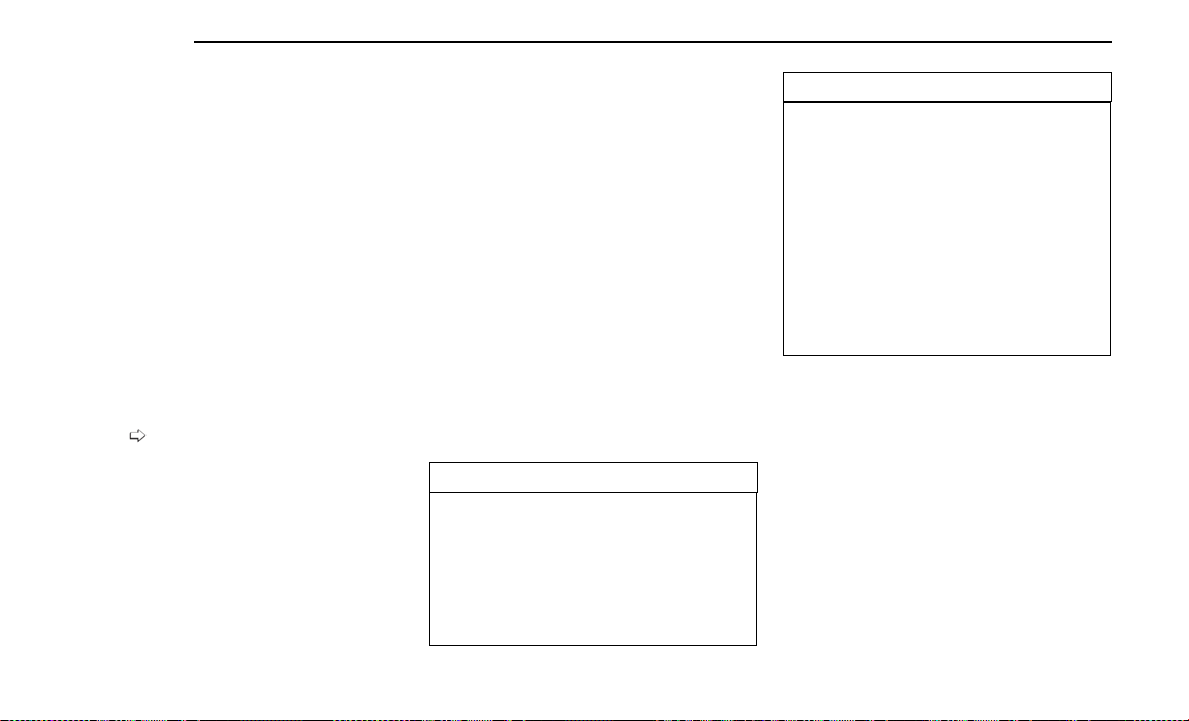Loading ...
Loading ...
Loading ...

visual warnings (shown in the instrument cluster). If the
driver determines acceleration is needed to avoid a
collision, when the accelerator is pressed ICA will
cancel.
TIRE PRESSURE MONITORING
SYSTEM (TPMS)
The TPMS will warn the driver of a low tire pressure
based on the vehicle recommended cold tire pressure.
The tire pressure will vary with temperature by about
1 psi (7 kPa) for every 12°F (6.5°C). This means that
when the outside temperature decreases, the tire pres-
sure will decrease. Tire pressure should always be set
based on cold inflation tire pressure. This is defined as
the tire pressure after the vehicle has not been driven
for at least three hours, or driven less than 1 mile
(1.6 km) after a three-hour period. The tire pressure will
also increase as the vehicle is driven — this is normal
and there should be no adjustment for this increased
pressure.
For information on how to properly inflate the vehicle’s
tires, see
page 325.
The TPMS will warn the driver of a low tire pressure if
the tire pressure falls below the low pressure warning
threshold for any reason, including low temperature
effects, or natural pressure loss through the tire.
The TPMS will continue to warn the driver of low tire
pressure as long as the condition exists, and will not
turn off until the tire pressure is at or above recom-
mended cold tire pressure. Once the low tire pressure
warning has been illuminated, the tire pressure must
be increased to the recommended cold tire pressure in
order for the TPMS Warning Light to be turned off.
NOTE:
When filling warm tires, the tire pressure may need to
be increased up to an additional 4 psi (28 kPa) above
the recommended cold placard pressure in order to
turn the TPMS Warning Light off.
The system will automatically update and the TPMS
Warning Light will extinguish once the updated tire
pressures have been received. The vehicle may need to
be driven for up to 20 minutes above 15 mph
(24 km/h) to receive this information.
For example, your vehicle has a recommended cold
(parked for more than three hours) tire pressure of
33 psi (227 kPa). If the ambient temperature is 68°F
(20°C) and the measured tire pressure is 28 psi
(193 kPa), a temperature drop to 20°F (-7°C) will
decrease the tire pressure to approximately 24 psi
(165 kPa). This tire pressure is sufficiently low enough
to turn on the TPMS Warning Light. Driving the vehicle
may cause the tire pressure to rise to approximately
28 psi (193 kPa), but the TPMS Warning Light will still
be on. In this situation, the TPMS Warning Light will turn
off only after the tires have been inflated to the vehi-
cle’s recommended cold tire pressure value.
CAUTION!
•
The TPMS has been optimized for the original
equipment tires and wheels. TPMS pressures and
warnings have been established for the tire size
equipped on your vehicle. Undesirable system
operation or sensor damage may result when
using replacement equipment that is not of the
same size, type, and/or style. The TPMS sensor is
not designed for use on aftermarket wheels and
may contribute to a poor overall system perfor-
(Continued)
CAUTION!
mance or sensor damage. Customers are encour-
aged to use Original Equipment Manufacturer
(OEM) wheels to ensure proper TPMS feature
operation.
•
Using aftermarket tire sealants may cause the Tire
Pressure Monitoring System (TPMS) sensor to
become inoperable. After using an aftermarket tire
sealant it is recommended that you take your
vehicle to an authorized dealership to have your
sensor function checked.
•
After inspecting or adjusting the tire pressure,
always reinstall the valve stem cap. This will pre-
vent moisture and dirt from entering the valve
stem, which could damage the Tire Pressure Moni-
toring System sensor.
NOTE:
•
The TPMS is not intended to replace normal tire
care and maintenance, or to provide warning of a
tire failure or condition.
•
The TPMS should not be used as a tire pressure
gauge while adjusting your tire pressure.
•
Driving on a significantly underinflated tire causes
the tire to overheat and can lead to tire failure.
Underinflation also reduces fuel efficiency and tire
tread life, and may affect the vehicle’s handling and
stopping ability.
240 SAFETY
Loading ...
Loading ...
Loading ...